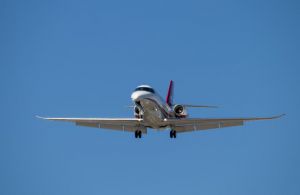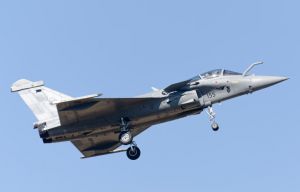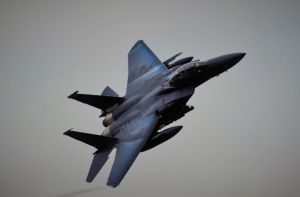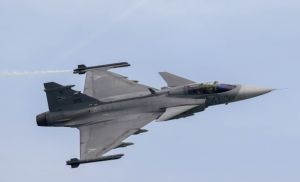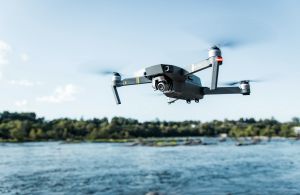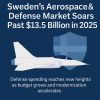Test Owner
Swedish electric aircraft startup Heart Aerospace is relocating its headquarters from Gothenburg to Los Angeles in a move it says will accelerate the development of its hybrid-electric passenger plane.
The transition will result in the layoff of all 75 employees in Sweden, according to company spokesperson Christina Zander. "Recruitment in the US is ongoing," she told TNW.
Founded in 2018, Heart Aerospace is developing the ES-30, a 30-seat hybrid-electric regional airliner. The first prototype, dubbed X1, is expected to take its maiden flight later this year.
Tobias Bengtsdahl, a partner at Stockholm-based VC firm Antler, said the decision underscores deeper issues in Europe’s tech ecosystem. “Europe’s over-regulation and lack of market appetite are actively driving innovation away,” he said. “Moves like this only reinforce the perception that the US is the better environment for building cutting-edge companies.”
To date, Heart Aerospace has raised nearly $200 million from investors including Breakthrough Energy Ventures, founded by Bill Gates, and the Swedish government. CEO and founder Anders Forslund said the relocation would allow the company to better concentrate its resources.
“Our customers, partners, and investors are increasingly based in the US,” Forslund said. “By consolidating operations in Los Angeles, we can move faster, collaborate more effectively, and strengthen our position for the future.”
The shift had been foreshadowed by several recent developments. In May 2024, Heart opened a research and development hub in Los Angeles. It previously conducted its first test flight in the US and secured a $4.1 million contract from the Federal Aviation Administration (FAA).
Heart has already booked 250 firm orders and 191 letters of intent for the ES-30. US airlines United and Mesa are among the major customers, while Scandinavian Airlines (SAS), Sweden’s Braathens Regional Airlines, and Icelandair have signed letters of intent covering 96 aircraft in total.
Despite the move, Zander emphasized that Heart's European partnerships remain intact. “Our Scandinavian investors and suppliers are still key collaborators,” she said. “Relocating to the US is a strategic step for prototype development, but Europe remains an essential part of our broader ecosystem.”
India has finalized a deal to purchase 26 Rafale fighter jets from France, the Ministry of Defence announced yesterday, expanding its fleet as part of a broader push to modernize its military forces.
The multi-billion-dollar agreement, signed between the two governments, will provide India with both single-seat and twin-seat variants of the Rafale, manufactured by French aerospace giant Dassault Aviation. These new jets will join the 36 Rafales India previously acquired, further strengthening its air power.
According to the Defence Ministry, the package includes not just the aircraft, but also training services, simulators, weapons, related equipment, and long-term maintenance support. Of the 26 jets, 22 will be single-seaters and four will be twin-seaters. The deal also covers additional equipment upgrades for the Indian Air Force’s existing Rafale fleet.
The jets are intended for deployment on India’s domestically built aircraft carriers, where they will replace aging Russian-made MiG-29K fighters.
India first announced its plans to buy these additional Rafales during Prime Minister Narendra Modi’s visit to France for Bastille Day celebrations in 2023.
Although India has historically relied on Russia for much of its military hardware, it has increasingly diversified its defense partnerships, making major acquisitions from France, the United States, and Israel in recent years.
Dassault Aviation praised the deal, stating the Rafales would provide India with advanced military capabilities and strengthen its role as a leading global power. The company also noted that India’s navy would become the first international operator of the Rafale Marine variant.
The signing of the agreement comes at a tense moment, as relations between India and Pakistan have deteriorated following a deadly militant attack in Kashmir on April 22 that left 26 people dead. Since the attack, tensions have escalated with diplomatic expulsions, border closures, and exchanges of gunfire, fueling concerns about a potential military confrontation.
India’s earlier contract for 36 Rafale jets, signed in 2016, was valued at around $9.4 billion.
As the world’s fifth-largest economy and most populous nation, India is increasingly seen as a crucial market by major arms suppliers. According to the Stockholm International Peace Research Institute (SIPRI), India became the world’s largest arms importer between 2019 and 2023, accounting for nearly 10% of all global weapons imports.
Sweden has announced plans to supply the Ukrainian Air Force with JAS 39 Gripen fighter jets, providing a much-needed boost to Ukraine’s air capabilities. As Ukraine faces an urgent need for Western fighter aircraft, the Gripen—Sweden’s most advanced multirole combat jet—stands out as a formidable addition to Ukraine’s defense arsenal.
With Sweden and Finland on the cusp of fully integrating into NATO after decades of neutrality, the decision to supply Gripens marks a significant geopolitical shift. It also highlights Sweden’s increasing role in European security and its commitment to supporting Ukraine amid ongoing Russian aggression.
The Saab JAS 39 Gripen: Sweden’s Most Impressive Fighter Jet
While many Americans associate the name Saab primarily with automobiles, the Swedish company has a long and storied history in aerospace and defense. Founded in Stockholm in 1937, Saab has been a leading innovator in aviation technology, producing renowned fighter jets such as the Tunnan, Lansen, Draken, and Viggen. The company remains a key player in global military aviation, collaborating with Boeing to develop the U.S. Air Force’s T-7 Red Hawk jet trainer.
The Gripen was developed as a successor to the aging Draken and Viggen aircraft, incorporating cutting-edge technology to ensure superior performance. Sweden sought a fighter that could achieve speeds of Mach 2, operate from short runways, and maintain a smaller footprint than the Viggen while carrying an increased payload. Before Saab was selected to develop an entirely new airframe, Sweden considered foreign alternatives, including the F-16, F/A-18, F-20, and Mirage 2000.
The Gripen’s Evolution and Challenges
Developing advanced fighter jets has always been a challenging and highly scrutinized process, and the Gripen was no exception. The aircraft encountered setbacks during its early testing phase, most notably two crashes that drew significant attention and criticism.
The first incident occurred in 1989 when test pilot Lars Rådstrom lost control on landing due to a pitch control error in the fly-by-wire system, resulting in a crash. The second accident took place in 1993 when Rådstrom ejected from the aircraft after a loss of control during a low-altitude roll. Investigations revealed that the issue stemmed from the aircraft’s flight control system amplifying the pilot’s joystick inputs. These setbacks required extensive corrections and system refinements, but ultimately, they led to the Gripen’s enhanced reliability and combat readiness.
Gripen vs. Russian Fighters: Implications for Ukraine
With Sweden’s NATO accession, the Gripen is likely to be compared to Russian fighter jets, particularly in the context of Ukraine’s ongoing war. While direct conflict between Sweden and Russia remains unlikely, Stockholm’s decision to supply Gripens to Ukraine serves multiple strategic purposes.
Firstly, it provides Ukraine with a highly capable fighter jet that has been designed for rapid deployment, electronic warfare, and adaptability in modern combat scenarios. Secondly, it allows Ukraine to battlefield-test the Gripen against Russian aircraft, providing valuable data on its effectiveness against adversaries like the Su-35 and MiG-31. Lastly, Sweden’s move contributes to prolonging Russia’s military engagement, further complicating Moscow’s strategic ambitions in the region.
The Future of Sweden’s Role in European Defense
By equipping Ukraine with Gripen fighter jets, Sweden is not only reinforcing Ukraine’s air power but also cementing its own position as a critical player in European defense. This decision underscores the shift in Sweden’s defense policy—from neutrality to active military support for its allies—and signals Sweden’s readiness to challenge Russian aggression through strategic military assistance.
As Ukraine continues to defend its sovereignty, the arrival of Gripen fighters could prove to be a game-changer in the ongoing war, offering advanced air capabilities that could tilt the balance in favor of Ukrainian forces. With Sweden now a member of NATO, its contributions to European security are set to grow, shaping the alliance’s strategic posture in the years to come.
The electric vertical takeoff and landing (eVTOL) sector has faced turbulent times in recent months, with some of Europe’s most promising players, Lilium and Volocopter, encountering severe financial difficulties. At one point, Lilium appeared on the brink of bankruptcy, raising serious concerns about the viability of the entire industry.
However, in what seemed like a Christmas miracle, the German-based eVTOL manufacturer managed to secure a fresh round of investment, allowing it to continue pursuing its ambitious urban air mobility vision. This financial boost came at a crucial time, offering Lilium a much-needed lifeline to further develop its cutting-edge aircraft technology.
Just as Lilium regained stability, reports surfaced that Volocopter, another major player in the eVTOL space, was also on the verge of collapse. These setbacks led many to question whether the Jetsons-style dream of air taxis was slowly slipping into oblivion. However, recent developments prove otherwise—the industry continues to attract investment, and innovation in aerospace technology remains strong.
Despite these challenges, several European aerospace startups are making remarkable progress, proving that the sky is still the limit. From hydrogen-powered jets to next-generation regional aircraft, these companies are shaping the future of aviation.
European Aerospace Startups to Watch in 2025
Airvolve (Lithuania) – Next-Gen Tactical Transport
✈️ Developing heavy-lift aerial vehicles for cargo, rescue, and defense
✈️ 10x lower costs than helicopters, 60 km range
✈️ €825K funding, USPTO patent pending
Beyond Aero (France) – Hydrogen-Powered Business Jets
✈️ First hydrogen-electric business jet, 1,500 km range
✈️ $20M funding (Giant Ventures, Bpifrance, Airbnb & Dropbox founders)
✈️ Building world’s most powerful Hydrogen Powertrain Lab
Heart Aerospace (Sweden) – Hybrid-Electric Regional Travel
⚡ 30-seat ES-30 hybrid-electric airliner, up to 800 km range
⚡ $107M Series B funding (Air Canada, United Airlines, Breakthrough Energy)
⚡ First test flights in 2025
Destinus (Switzerland/Netherlands) – Supersonic & Hypersonic Aviation
⚡Developing hydrogen-powered supersonic aircraft
⚡Supersonic prototype in 2026, hypersonic aircraft by 2030
⚡ Relocated HQ to Netherlands for defense R&D
VÆRIDION (Germany) – Zero-Emission Microliners
✈️ 9-passenger electric aircraft, 500 km range
✈️ First General Aviation startup to begin EASA certification
✈️ €14M Series A funding (World Fund, Vsquared Ventures)
Airbus CEO Guillaume Faury Envisions Potential Collaboration Between European Fighter Jet Programs
Airbus CEO Guillaume Faury has expressed optimism about the possibility of merging or aligning two separate European programs currently developing next-generation fighter jets and advanced combat air systems. These initiatives, spearheaded by different alliances, have been the subject of speculation regarding their financial and strategic viability.
In December, Britain, Italy, and Japan announced the formation of a joint effort to design and build a stealth fighter jet named the Global Combat Air Programme (GCAP). Simultaneously, France, Germany, and Spain are advancing the competing Future Combat Air System (FCAS) project. Defense analysts have long debated whether Europe has the resources or market demand to sustain two parallel initiatives of such scale.
Speaking to reporters on Wednesday, Faury suggested that consolidating efforts or ensuring compatibility between the two programs would be a logical move.
Room for Collaboration
"I think there's really room to do things in a smart way," Faury stated. "Each and every country could contribute its financial and technological capacity to a bigger program for Europe, because that's what we need at the end."
Faury emphasized that while no definitive plans for collaboration exist, budgetary constraints and shared objectives might prompt governments to explore unification in the near future. He projected that discussions could begin within the next few years as technological development phases for both programs conclude.
The Path Toward Integration
According to Faury, the governments involved in FCAS and GCAP will need to convene at the appropriate time to assess the progress and objectives of their respective programs. "The governments ... need to sit down at the point in time when they have a clear view on what is FCAS, what is GCAP, what they want to achieve, and see what they can do better together," he explained.
The anticipated timeline for these discussions coincides with the completion of the initial technology phases for both programs, potentially within the next two years. However, Faury acknowledged that merging such large-scale efforts would be fraught with complexity.
"If you have too many players, it's a difficult thing," he cautioned, underscoring the challenges of coordinating among multiple stakeholders with differing priorities, financial commitments, and technological contributions.
Strategic Implications for Europe
The potential alignment of FCAS and GCAP would mark a significant shift in Europe's defense strategy, allowing the region to pool resources and expertise to compete on a global scale. A unified program could strengthen Europe's position in the advanced combat systems market while addressing concerns about fragmented investments and limited procurement orders.
Yet, bringing the two initiatives together would involve navigating political, industrial, and operational challenges. Differences in timelines, technology roadmaps, and strategic goals would need to be reconciled. Additionally, the integration of players from diverse nations, including non-European partner Japan in GCAP, adds another layer of complexity.
Heart Aerospace to Launch Historic All-Electric H-X1 Flight at Plattsburgh International Airport in 2025
Heart Aerospace has announced that Plattsburgh International Airport in New York will host the inaugural flight of its all-electric Heart-X1 (H-X1) demonstrator, scheduled for the second quarter of 2025.
This decision marks a key step toward realizing the company’s vision for electric aviation. The full-scale H-X1 demonstrator, featuring a 32-meter wingspan, was unveiled in September 2024, with the company expressing its ambition to fly the aircraft the following year. Plattsburgh was chosen for its expansive airfield infrastructure, low air traffic density, and strong regional support for transportation technology innovation. The aircraft is set to be transported to the site in early 2025.
Currently stationed at Heart’s Gothenburg, Sweden headquarters, the H-X1 is undergoing rigorous testing of critical systems in preparation for its historic all-electric flight. Heart Aerospace co-founder and CEO Anders Forslund highlighted the team’s achievement: “It is a testament to the ingenuity and dedication of our team that we’ve been able to roll out a 30-seat aircraft demonstrator with a brand-new propulsion system, largely in-house, in less than two years.”
Advancing Electric Aviation with the HX-2 and ES-30
Following the H-X1, Heart Aerospace plans to develop a second pre-production model, the HX-2, which will further refine the company’s design and production techniques. The HX-2 is slated for a hybrid-electric first flight in 2026.
The initial flight campaign of the H-X1 will play a pivotal role in validating Heart’s electric propulsion technology, shaping the development of its flagship project, the ES-30 hybrid-electric regional airliner. The ES-30 is designed to accommodate 30 passengers with an all-electric range of 200 km and an extended hybrid range of 400 km. Certification for the ES-30 is targeted by the end of the decade.
Pioneering Regional Air Mobility
Forslund emphasized the potential of electric aviation to transform regional air travel: “Electric commercial airplanes have the potential to lower operating costs for US airlines, creating a powerful opportunity to re-establish regional air routes. We’re impressed by the leadership shown by New York’s North Country region in supporting the next generation of airplanes.”
Heart Aerospace’s commitment to innovation and sustainability positions it as a leader in the push for greener, more efficient regional air travel. The upcoming inaugural flight at Plattsburgh International Airport represents a significant milestone in this journey.
Swedish defense manufacturer Saab has formally presented an offer to Colombia for the sale of an undisclosed number of Gripen fighter jets and is pursuing a similar potential deal with Peru, according to Saab CEO Micael Johansson.
Colombia’s interest in the Gripen jets follows a recent report from Swedish public radio that suggested the country was considering purchasing a fleet of JAS Gripen jets, which Saab produces in part through a joint manufacturing line in Brazil.
"We’ve extended a comprehensive offer, and Colombia is evaluating it," Johansson stated. "We believe our offer is strong, but of course, there’s always competition."
The push in Colombia aligns with Saab's expanding presence in Brazil. Over the weekend, Brazil increased its own order of JAS 39 Gripen fighters by 25%, with an agreement that also included Sweden's acquisition of Brazilian aerospace company Embraer's C-390 military cargo planes. A letter of intent was signed between Swedish Defense Minister Pal Jonson and Brazilian Defense Minister Jose Mucio, with a final contract still pending.
This increased demand has bolstered Saab's manufacturing operations in Brazil, with additional Gripens slated to be assembled at Embraer’s Gaviao Peixoto facility in São Paulo, where production began last year. Saab and Embraer aim to position the facility as a regional hub for Gripen production, facilitating further deals across Latin America.
Saab’s expansion strategy in the region could extend beyond Colombia. Johansson noted that Saab is also actively engaged in discussions with Peru, which has reportedly set aside funding to begin its acquisition process for new fighter jets.
"Brazil serves as an ideal base to support sales in South America," Johansson said, adding that while Colombia’s negotiations are further along, Peru presents another promising opportunity as they have established a budget for aircraft purchases.
Saab's efforts in Latin America come as part of its broader strategy to grow its market presence in the region, capitalizing on its Brazilian production capabilities to meet regional demand. Following the weekend's announcements, Saab’s stock rose approximately 4% on Monday, reflecting investor optimism regarding Saab's progress in Latin America.
Artificial intelligence (AI) has become a game-changing force across numerous industries, from healthcare to finance. The technology’s ability to optimize processes, improve decision-making, and unlock new opportunities has made its rise inevitable. Yet, in the Aerospace and Defense (A&D) sector, the adoption of AI has been more measured compared to other industries. Given the high stakes involved—whether in the cockpit of a commercial jet or on the battlefield—the slower pace of AI integration reflects a cautious approach driven by safety and reliability concerns.
In this article, we will explore the current state of AI deployment in the aerospace and defense industry and why its adoption, though promising, is progressing at a slower pace compared to other sectors.
Why the Aerospace and Defense Industry Is Slower to Adopt AI
Unlike industries where AI errors may result in financial losses or operational inefficiencies, a malfunction in the aerospace and defense sector could have far more severe consequences. A faulty AI system in the manufacturing of consumer goods might lead to distribution issues or subpar products. However, a flawed AI in a fighter jet's navigation system or an airliner's autopilot could result in catastrophic failure, risking lives and national security.
This level of risk has compelled the industry to prioritize safety and redundancy in its AI applications, ensuring that any deployed AI system is rigorously tested and failsafe. The slower pace also reflects the stringent regulatory requirements that govern aerospace and defense technologies. Despite these challenges, the industry is finding innovative ways to integrate AI into various facets of its operations, leading to notable advancements.
AI in Aviation: Improving Efficiency and Customer Experience
AI is making headway in the aviation industry in areas where human interaction is reduced or eliminated altogether. For instance, contactless technologies like automated airport check-ins and biometric passport controls are becoming standard features in many international airports. These systems, powered by AI, enhance security, reduce wait times, and streamline the passenger experience.
In addition, airlines are using AI to optimize dynamic ticket pricing. By analyzing load factors, market trends, and customer behavior, AI systems help airlines maximize revenue by adjusting ticket prices in real-time based on demand and available seats.
Another significant AI application is in delay prediction. By using machine learning models that analyze weather conditions, air traffic data, and historical flight patterns, airlines can better anticipate delays and notify passengers sooner, ultimately improving customer satisfaction.
AI is also transforming flight dispatch and crew scheduling, with algorithms now being used to optimize flight routes for fuel efficiency and to manage complex crew rosters. Predictive maintenance, enabled by AI, is reducing downtime by flagging potential mechanical issues before they lead to costly repairs, thus ensuring smoother operations and increased profitability for airlines.
AI's Role in Satellite Management
AI is proving instrumental in managing the growing number of satellite constellations orbiting the Earth. The cost of maintaining these satellites can reach hundreds of millions of dollars annually. AI, however, is changing this dynamic by enabling smarter, more autonomous satellite operations. AI systems can detect anomalies, adjust orbits, and optimize performance without human intervention, potentially reducing costs to just $10-15 million, according to satellite manufacturer Phantom Space.
This use of AI not only cuts operational costs but also enhances the reliability and resilience of space-based infrastructure, which is critical for applications ranging from communication to global positioning systems (GPS) and Earth observation.
AI in Aerospace Manufacturing: Speed and Precision
The aerospace sector is also using AI to improve aircraft production. By analyzing production data, AI can identify ways to optimize manufacturing processes, thereby reducing costs and speeding up production times. For example, Broetje-Automation, a German company, uses AI algorithms to design fuselage skin-fastening machines. These AI-powered systems have significantly improved efficiency, replacing manual, judgment-based processes with more precise, automated workflows.
With AI, manufacturers can streamline their supply chains, enhance quality control, and reduce waste, all of which contribute to better margins and faster turnaround times in aircraft production.
Federal Funding Driving AI Innovation in Defense
In the defense sector, government support plays a key role in accelerating AI development. The U.S. Department of Defense (DoD) has significantly increased its investment in AI technologies, spending $874 million on AI initiatives in 2022, a 50% increase from the previous year. This figure surged to $1.8 billion in 2023, underscoring the growing importance of AI in military applications.
Federal funding is crucial not only for research and development but also for incentivizing private companies in the A&D industry to adopt and integrate AI into their operations. Companies that embrace AI are likely to secure more lucrative government contracts, further driving the sector’s overall adoption of the technology.
AI-Powered Mergers and Acquisitions in Aerospace and Defense
As AI becomes more central to aerospace and defense operations, we are seeing an increase in M&A activity involving AI-focused startups and established industry players. Large A&D firms, which may lack the internal resources to develop AI technologies in-house, are increasingly looking to acquire specialized AI companies to integrate their innovations into existing platforms.
Recent examples include AeroVironment’s $120 million acquisition of Tomahawk Robotics, a company that develops AI-based control systems for military robots, and Parsons Corporation’s $200 million purchase of Sealing Technologies, an AI-focused cybersecurity firm. Similarly, Saab recently acquired CrowdAI, a startup specializing in visual automation powered by AI.
On the flip side, startups that have raised capital through venture funding may seek partnerships or acquisitions by larger firms to gain access to established supply chains, government contracts, and capital resources.
Looking Ahead: The Future of AI in Aerospace and Defense
While the aerospace and defense industry has been slower to adopt AI compared to other sectors, the potential for transformative change is undeniable. As AI tools continue to mature, they will help aerospace and defense companies improve efficiency, cut costs, and unlock new capabilities in areas ranging from aircraft design to satellite management and military operations.
In the coming years, we can expect AI to become even more deeply embedded in the A&D sector, leading to greater innovations, higher profit margins, and a competitive edge for companies that successfully navigate the complexities of AI integration. As AI technologies continue to evolve, the aerospace and defense industry is poised to soar into a new era of efficiency, safety, and technological excellence.
French jet engine manufacturer Safran has announced the acquisition of AI firm Preligens for €220 million ($243.3 million), marking a strategic move to enhance its artificial intelligence capabilities, particularly in its Electronics & Defense sector.
According to a press release issued on September 2, Safran plans to rebrand Preligens as Safran.AI. By integrating the AI firm into its Electronics & Defense division, Safran aims to accelerate the development of AI-driven products and services. Jean-Yves Courtois, CEO of Safran Electronics & Defense, highlighted that this acquisition will enable the company to deliver more reliable information and decision-making support for operators involved in surveillance and identification tasks within the defense and space industries.
Safran also intends to apply Preligens’ AI technologies to Industry 4.0 initiatives, such as automated image analytics, to help quality controllers identify anomalies in critical components.
Founded in 2016, Preligens has earned a strong reputation for its AI analytics solutions, particularly in processing high-resolution imagery, full-motion video, and acoustic signals. The company’s unique AI Factory allows for the development of cutting-edge AI algorithms, trained on vast datasets from diverse sources, ensuring end-to-end security and traceability.
Safran’s Commitment to AI Innovation in Aerospace and Defense
This acquisition strengthens Safran’s technological capabilities and reinforces its position as a leader in utilizing AI to transform the aerospace and defense sectors.
With its strong international presence, Safran is well-equipped to support Preligens’ global expansion, particularly in the US market. In a related effort, Safran Electronics & Defense launched its Advanced Cognitive Engine (ACE) AI system on June 19. ACE is designed to incorporate AI across all Safran Electronics & Defense products, improving situational awareness, decision support, and reducing the cognitive burden on field forces.
The use of AI in defense and aerospace has seen significant growth in recent years. Notably, in February 2023, an AI agent successfully piloted Lockheed Martin’s VISTA X-62A fighter jet for over 17 hours at the U.S. Air Force Test Pilot School at Edwards Air Force Base, California. This milestone is seen as a precursor to the next generation of fighter jets, which may operate autonomously without human pilots.
The Future Combat Air System (FCAS), a bold initiative led by Germany, France, and Spain—with Belgium recently joining as an observer—aims to revolutionize air warfare in mainland Europe by the 2040s. This ambitious program seeks to integrate artificial intelligence (AI) deeply into every aspect of its operations, potentially making it the first large-scale defense project with AI fully embedded.
The FCAS project envisions a suite of advanced warplanes and drones, with airworthy prototypes expected to take flight by the end of this decade. According to engineers and experts interviewed by Defense News, AI will be central to the system's development, influencing everything from design processes to real-time combat decisions and even what pilots see in their cockpits.
A key innovation of FCAS is the introduction of "loyal wingmen"—autonomous drones designed to fly alongside manned aircraft, enhancing missions by gathering more data, providing additional firepower, or overwhelming enemy defenses through sheer numbers. Thomas Grohs, Airbus’ head of future capabilities and chief engineer for FCAS, emphasized that these drones will require a significant level of automation or autonomy to operate effectively, as manual control from the cockpit would be impractical.
The challenge lies in determining the optimal balance of pilot involvement across different scenarios, which will be crucial to the program's overall success.
Always Connected
NeuralAgent, a Munich-based startup led by Onur Deniz, is tasked with ensuring seamless data flow across the system. The company is adopting an "AI agent approach," where each drone operates autonomously using locally-run AI models, rather than relying on a centralized, cloud-based system. These drones will communicate with each other through various channels, including optical, narrowband radio, and infrared, constantly maintaining dynamic and redundant data links for uninterrupted connectivity.
Deniz explained that this decentralized approach has proven highly effective in computer simulations, maintaining connectivity in challenging electronic warfare environments over 95% of the time. By contrast, centralized systems had a success rate of less than 0.5% in similar tests. NeuralAgent plans to have its software ready for integration into existing hardware by the end of 2025, initially focusing on legacy systems. The company boasts that its models are highly resource-efficient, capable of running on minimal hardware like a Raspberry Pi with less than a gigabyte of space.
Organizing the AI-Driven Future
Initially, the AI models within FCAS will be "frozen," meaning no machine learning will occur during missions. Algorithms for tasks such as sensor data processing and target selection will be pre-developed and updated off-board.
AI will play a significant role in the entire observe, orient, decide, and act (OODA) loop, a key framework in military command. It will enhance sensor data quality, aid in decision-making, and potentially influence targeting decisions. However, the extent to which AI will autonomously make such critical decisions remains a topic of ongoing discussion.
Despite limited information on the final appearance and capabilities of FCAS, the resources committed to the project are immense. Airbus alone has over 1,400 people working on this next-generation air combat platform, in partnership with Dassault Aviation in France. Integrating AI-based algorithms across countless companies and thousands of engineers presents a significant challenge, as AI models have complex dependencies on one another and the data they process.
Ethical Concerns and the Role of AI
While the integration of AI offers promising advancements, it has also raised concerns among nongovernmental organizations and experts on autonomous weapons. Issues such as the reliability of machine vision, the opacity of AI decision-making processes, and the potential for AI to apply a tactical mindset to strategic decisions are at the forefront of ethical debates.
Some analysts worry that, even if a weapon system is not initially designed to kill autonomously, it could easily be modified to do so through a simple software update—a change that might be tempting in certain conflict scenarios.
As FCAS continues to evolve, the debate over the role of AI in making life-and-death decisions in warfare is likely to intensify. However, one thing is clear: AI will be deeply intertwined with the future of air combat, shaping not only the technology itself but also the ethical frameworks that govern its use.

